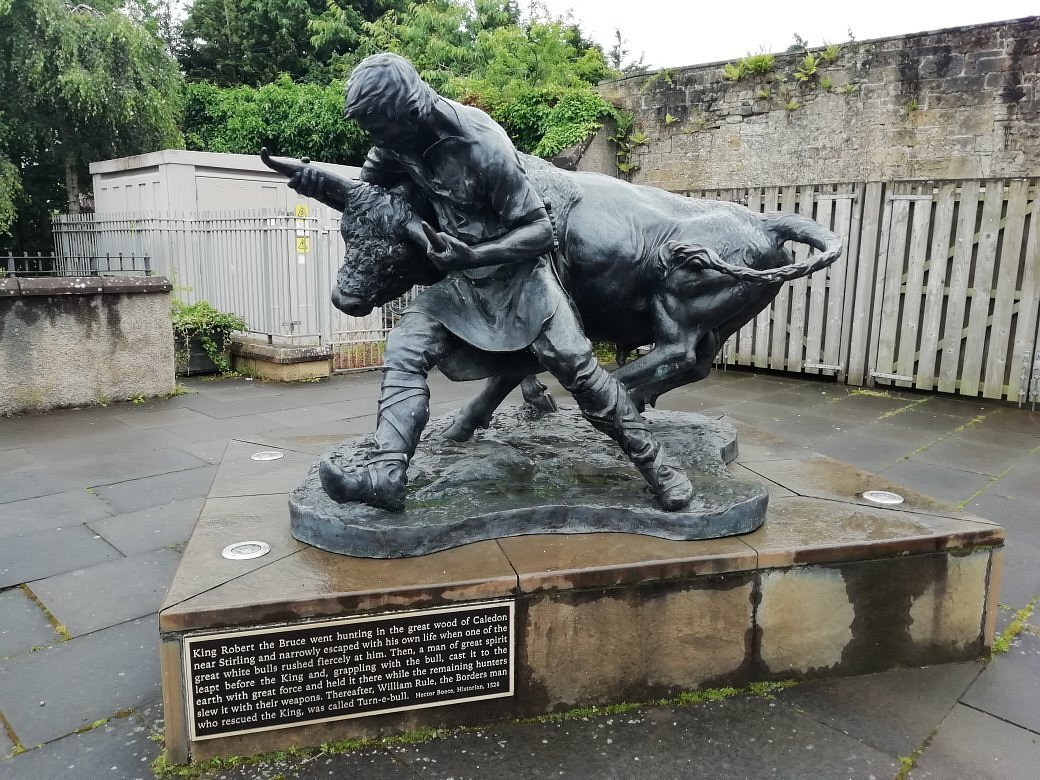 William Rule, a man of the Rule River, was well known for his strength and abilities in many activities. The man lived by the River Rule and appears on several records throughout the 13th century. In 1300, his name appears upon a record as a witness for a grant of land to the Monks of Kelso from the Throne of England Edward the First.
William Rule, a man of the Rule River, was well known for his strength and abilities in many activities. The man lived by the River Rule and appears on several records throughout the 13th century. In 1300, his name appears upon a record as a witness for a grant of land to the Monks of Kelso from the Throne of England Edward the First.
The Fullest account of the whole situation was written by Hector Boece, an early Scottish Historian, in his Book "History of Scotland" which was published in Paris in 1526. The tale has been retold many times, but the most famous was by poet John Leydon in his "Scene's of Infancy".
At the time, the Rule Water area was in the Barony of the House of Douglas. The Rules were well known for their fighting qualities and in exchange for military services were given small lairdships throughout the area. A very happy arrangement for both parties; the Barony of Douglas for having such a well fitted army, and the Rules for the titles and benefits.
Sir James Douglas, a close friend of Robert The Bruce, may well have been the reason William Rule was with the King's hunting party that day.
By account a wild bull rushed the King of Scotland. This is another often disputed factor within our history. Those who choose the believe our name was not based on this, often dispute the legend because in the John Leydon poem he says a wild bison charges the king after shaking his yellow mane. The argument says there were no bison in Scotland, and that bison have no yellow mane. In defense to this, we simply tell them to re-read the poem but with a poets eyes. Poets everywhere have been known to use a poetic license in writing material. BUT, if we take a look at a Highland cow, we see that they have a thick growth of hair at their neck and in fact are a yellow color. " Therefore...a yellow mane"
In 1313 William leapt before the King, turned the bull down and killed it. Whether he killed it himself or others assisted we do not know. One point to consider is that if a large animal like a bull is turned hard and sharp onto his back...head first. The weight of it may very well break it's neck. As far as turning a bull, the event has happened before and will again.
In (ca.) 1315 the lands of the Western Part of the estates of Philiphaugh in Selkirkshire were given to William Rule, and he was dubbed Turn-e-bull. The payment is reported as being one broad arrow each Assumption Day of The Virgin (August 15). The name Turnbull never appeared before this date and after this date, the name Rule disappears and the new name Turnbull is known.
William became a national hero, his name was far and wide and his legend growing ever bigger.
Unfortunately, in 1333 at the Battle of Halidon Hill he met is fate. The battle against the English was led by a Douglas over a town called Berwick. William and his Huge Dog went to the front of the Scottish army and challenged any English soldier to fight him. A Sir Robert Benhale took William up on his challenge. Apparently the dog attacked first, and the knight cut the dog in two and after that a battle between the two. William lost first his arm, then his head. The Battle was lost and the English killed the Leader Douglas
A final story is told about William Turnbull's (ne Rule) fate. The story is out of the "Churches and Churchyards of Teviotdale" published in 1893 and written by James Robson.
The story goes to say, that in Digging graves in Bedrule, large bones were often found and unearthed. These bones were believed to be from the Turnbull Clan Chieftains as they were known to be men of very large and powerful build. The story is said be true because the writer can vouch for it's accuracy.
Upon digging one day, two men came across two very large thigh bones and had no difficulty in identifying them as those of William Turnbull the man who saved the king. The two men took the bones and to avoid suspicion placed one down each of their pant legs. The two soon found that placing them was not as easy as they thought...and thus one was buried in a "yaird" on the east and one on the west side of the village of Denholm..a neighboring village. It is also said they are there today.
This information about William Rule, who was the first Turnbull. The information was collected from the "I saved The King" by R. E. Scott and "RuleWater and It's People" by George Tancred.


































.jpeg#joomlaImage://local-images/tcalibrary/museum/vmpeople/John%20I%20Turnbull%20(Jack).jpeg?width=960&height=1169)







.jpg#joomlaImage://local-images/tcalibrary/museum/vmpeople/Malcolm_Turnbull_PEO_(cropped).jpg?width=656&height=960)
















